Importance of Diversity and Inclusion in Educational Settings
VerifiedAdded on 2022/11/30
|9
|2217
|297
AI Summary
This essay discusses the importance of diversity and inclusion in educational settings and the need to celebrate differences rather than just accepting them.
Contribute Materials
Your contribution can guide someone’s learning journey. Share your
documents today.
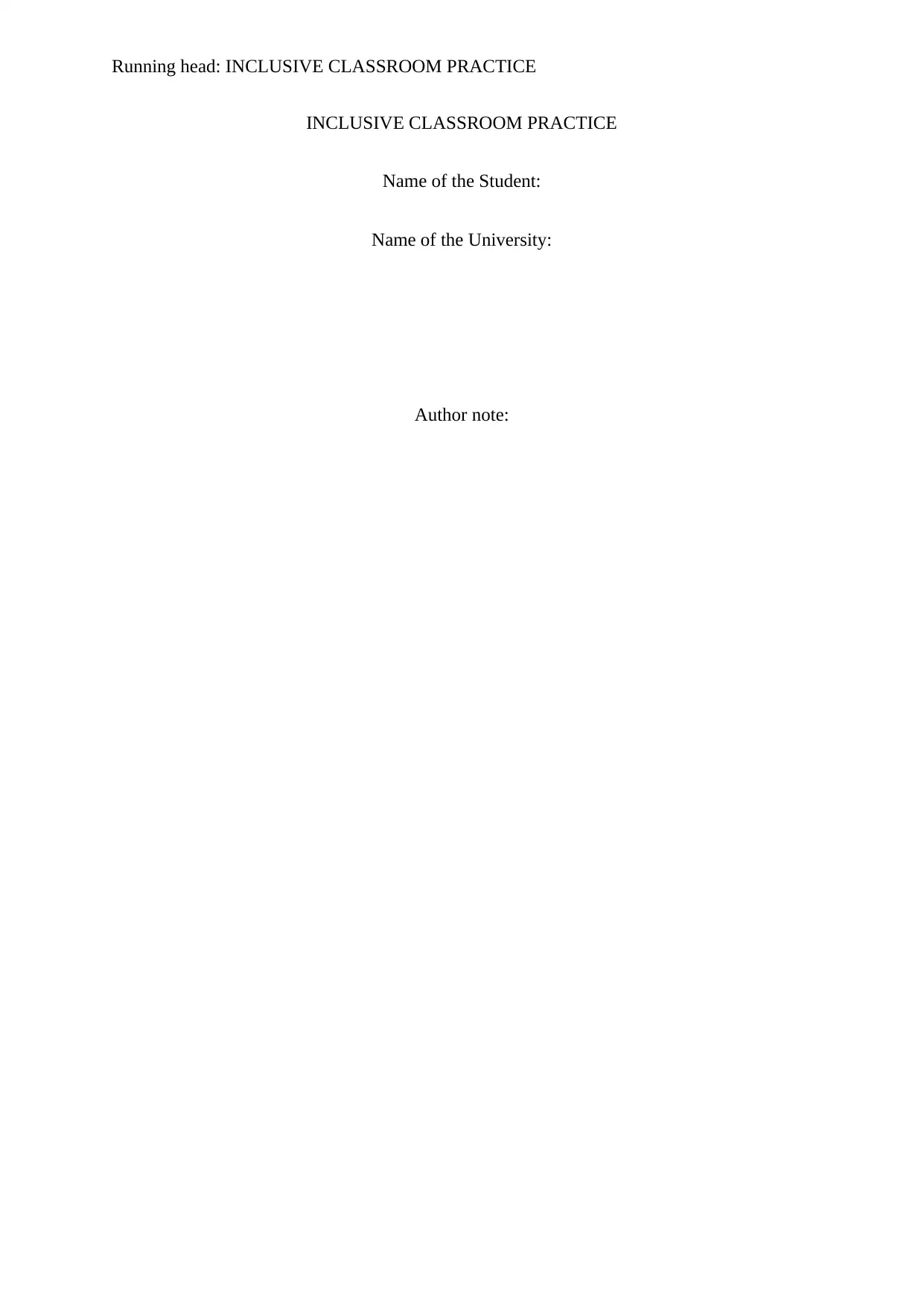
Running head: INCLUSIVE CLASSROOM PRACTICE
INCLUSIVE CLASSROOM PRACTICE
Name of the Student:
Name of the University:
Author note:
INCLUSIVE CLASSROOM PRACTICE
Name of the Student:
Name of the University:
Author note:
Secure Best Marks with AI Grader
Need help grading? Try our AI Grader for instant feedback on your assignments.
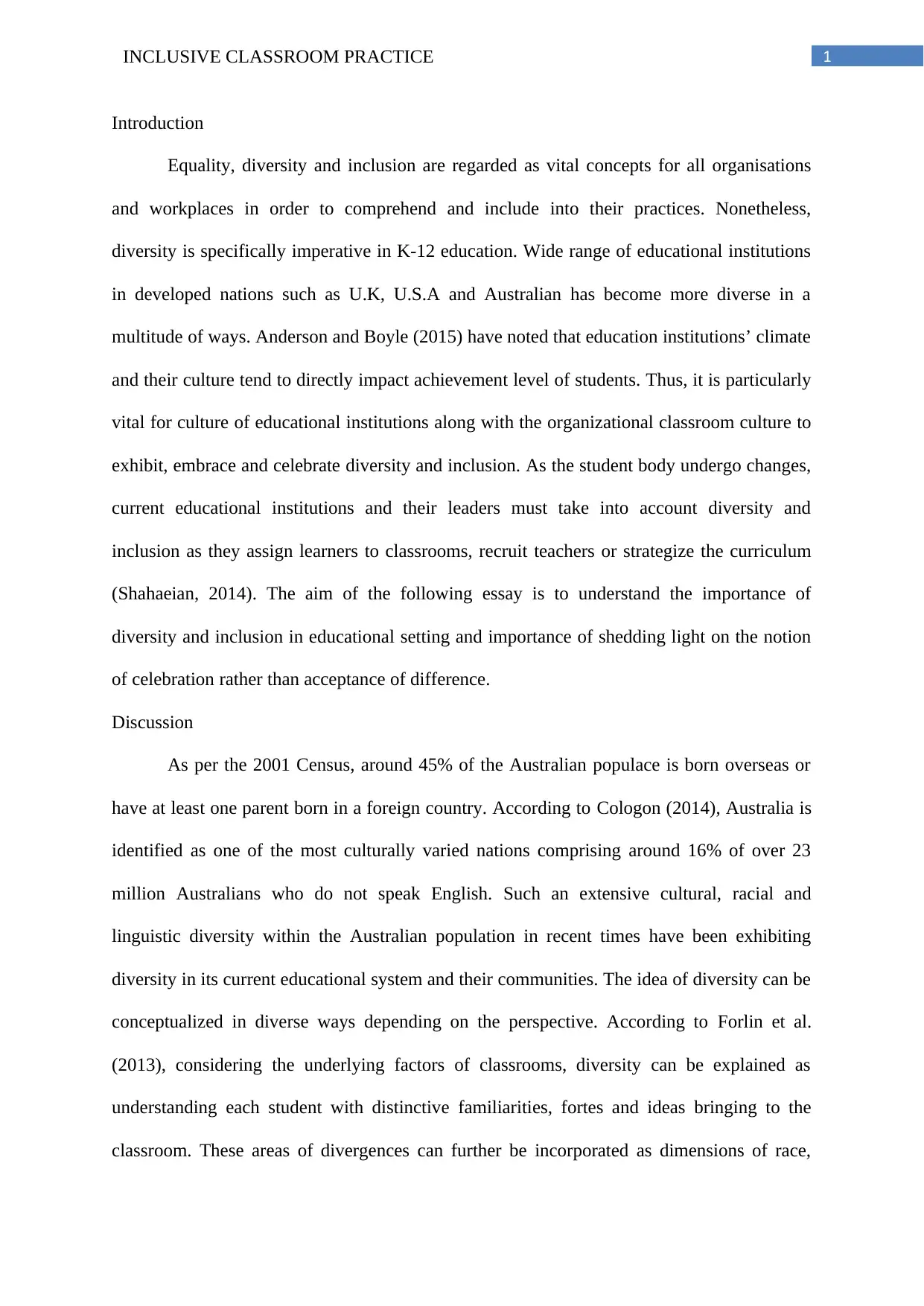
1INCLUSIVE CLASSROOM PRACTICE
Introduction
Equality, diversity and inclusion are regarded as vital concepts for all organisations
and workplaces in order to comprehend and include into their practices. Nonetheless,
diversity is specifically imperative in K-12 education. Wide range of educational institutions
in developed nations such as U.K, U.S.A and Australian has become more diverse in a
multitude of ways. Anderson and Boyle (2015) have noted that education institutions’ climate
and their culture tend to directly impact achievement level of students. Thus, it is particularly
vital for culture of educational institutions along with the organizational classroom culture to
exhibit, embrace and celebrate diversity and inclusion. As the student body undergo changes,
current educational institutions and their leaders must take into account diversity and
inclusion as they assign learners to classrooms, recruit teachers or strategize the curriculum
(Shahaeian, 2014). The aim of the following essay is to understand the importance of
diversity and inclusion in educational setting and importance of shedding light on the notion
of celebration rather than acceptance of difference.
Discussion
As per the 2001 Census, around 45% of the Australian populace is born overseas or
have at least one parent born in a foreign country. According to Cologon (2014), Australia is
identified as one of the most culturally varied nations comprising around 16% of over 23
million Australians who do not speak English. Such an extensive cultural, racial and
linguistic diversity within the Australian population in recent times have been exhibiting
diversity in its current educational system and their communities. The idea of diversity can be
conceptualized in diverse ways depending on the perspective. According to Forlin et al.
(2013), considering the underlying factors of classrooms, diversity can be explained as
understanding each student with distinctive familiarities, fortes and ideas bringing to the
classroom. These areas of divergences can further be incorporated as dimensions of race,
Introduction
Equality, diversity and inclusion are regarded as vital concepts for all organisations
and workplaces in order to comprehend and include into their practices. Nonetheless,
diversity is specifically imperative in K-12 education. Wide range of educational institutions
in developed nations such as U.K, U.S.A and Australian has become more diverse in a
multitude of ways. Anderson and Boyle (2015) have noted that education institutions’ climate
and their culture tend to directly impact achievement level of students. Thus, it is particularly
vital for culture of educational institutions along with the organizational classroom culture to
exhibit, embrace and celebrate diversity and inclusion. As the student body undergo changes,
current educational institutions and their leaders must take into account diversity and
inclusion as they assign learners to classrooms, recruit teachers or strategize the curriculum
(Shahaeian, 2014). The aim of the following essay is to understand the importance of
diversity and inclusion in educational setting and importance of shedding light on the notion
of celebration rather than acceptance of difference.
Discussion
As per the 2001 Census, around 45% of the Australian populace is born overseas or
have at least one parent born in a foreign country. According to Cologon (2014), Australia is
identified as one of the most culturally varied nations comprising around 16% of over 23
million Australians who do not speak English. Such an extensive cultural, racial and
linguistic diversity within the Australian population in recent times have been exhibiting
diversity in its current educational system and their communities. The idea of diversity can be
conceptualized in diverse ways depending on the perspective. According to Forlin et al.
(2013), considering the underlying factors of classrooms, diversity can be explained as
understanding each student with distinctive familiarities, fortes and ideas bringing to the
classroom. These areas of divergences can further be incorporated as dimensions of race,
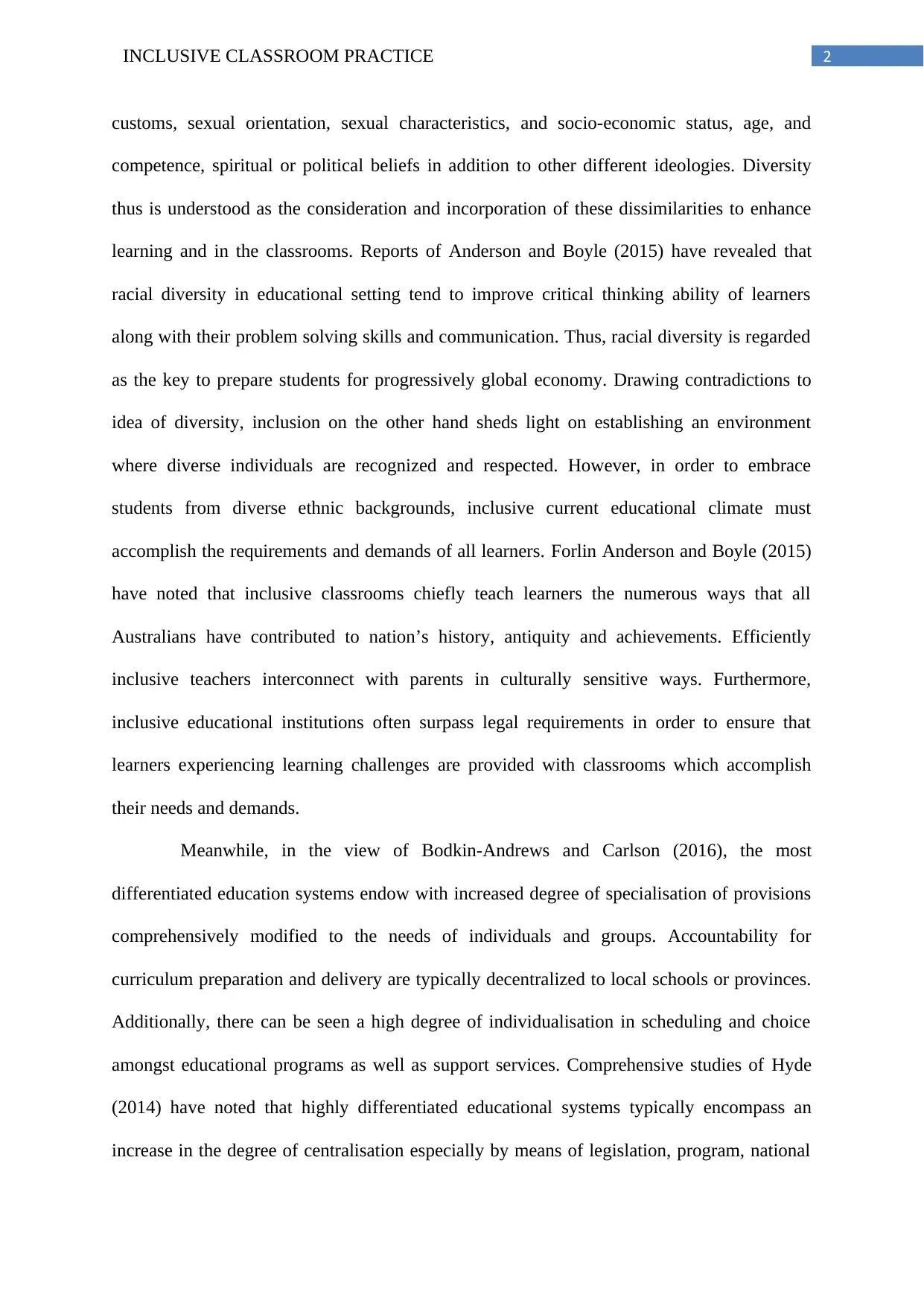
2INCLUSIVE CLASSROOM PRACTICE
customs, sexual orientation, sexual characteristics, and socio-economic status, age, and
competence, spiritual or political beliefs in addition to other different ideologies. Diversity
thus is understood as the consideration and incorporation of these dissimilarities to enhance
learning and in the classrooms. Reports of Anderson and Boyle (2015) have revealed that
racial diversity in educational setting tend to improve critical thinking ability of learners
along with their problem solving skills and communication. Thus, racial diversity is regarded
as the key to prepare students for progressively global economy. Drawing contradictions to
idea of diversity, inclusion on the other hand sheds light on establishing an environment
where diverse individuals are recognized and respected. However, in order to embrace
students from diverse ethnic backgrounds, inclusive current educational climate must
accomplish the requirements and demands of all learners. Forlin Anderson and Boyle (2015)
have noted that inclusive classrooms chiefly teach learners the numerous ways that all
Australians have contributed to nation’s history, antiquity and achievements. Efficiently
inclusive teachers interconnect with parents in culturally sensitive ways. Furthermore,
inclusive educational institutions often surpass legal requirements in order to ensure that
learners experiencing learning challenges are provided with classrooms which accomplish
their needs and demands.
Meanwhile, in the view of Bodkin-Andrews and Carlson (2016), the most
differentiated education systems endow with increased degree of specialisation of provisions
comprehensively modified to the needs of individuals and groups. Accountability for
curriculum preparation and delivery are typically decentralized to local schools or provinces.
Additionally, there can be seen a high degree of individualisation in scheduling and choice
amongst educational programs as well as support services. Comprehensive studies of Hyde
(2014) have noted that highly differentiated educational systems typically encompass an
increase in the degree of centralisation especially by means of legislation, program, national
customs, sexual orientation, sexual characteristics, and socio-economic status, age, and
competence, spiritual or political beliefs in addition to other different ideologies. Diversity
thus is understood as the consideration and incorporation of these dissimilarities to enhance
learning and in the classrooms. Reports of Anderson and Boyle (2015) have revealed that
racial diversity in educational setting tend to improve critical thinking ability of learners
along with their problem solving skills and communication. Thus, racial diversity is regarded
as the key to prepare students for progressively global economy. Drawing contradictions to
idea of diversity, inclusion on the other hand sheds light on establishing an environment
where diverse individuals are recognized and respected. However, in order to embrace
students from diverse ethnic backgrounds, inclusive current educational climate must
accomplish the requirements and demands of all learners. Forlin Anderson and Boyle (2015)
have noted that inclusive classrooms chiefly teach learners the numerous ways that all
Australians have contributed to nation’s history, antiquity and achievements. Efficiently
inclusive teachers interconnect with parents in culturally sensitive ways. Furthermore,
inclusive educational institutions often surpass legal requirements in order to ensure that
learners experiencing learning challenges are provided with classrooms which accomplish
their needs and demands.
Meanwhile, in the view of Bodkin-Andrews and Carlson (2016), the most
differentiated education systems endow with increased degree of specialisation of provisions
comprehensively modified to the needs of individuals and groups. Accountability for
curriculum preparation and delivery are typically decentralized to local schools or provinces.
Additionally, there can be seen a high degree of individualisation in scheduling and choice
amongst educational programs as well as support services. Comprehensive studies of Hyde
(2014) have noted that highly differentiated educational systems typically encompass an
increase in the degree of centralisation especially by means of legislation, program, national
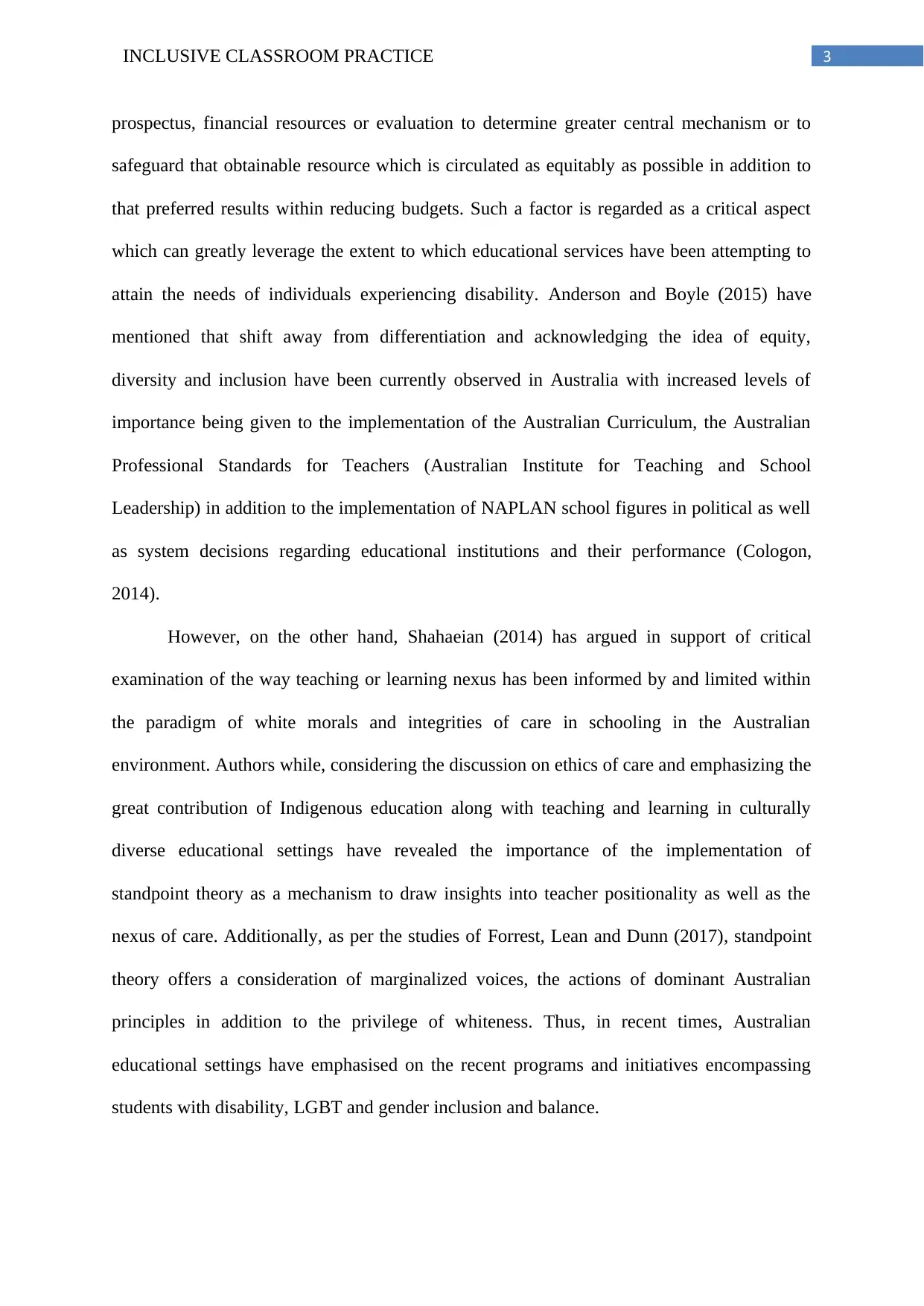
3INCLUSIVE CLASSROOM PRACTICE
prospectus, financial resources or evaluation to determine greater central mechanism or to
safeguard that obtainable resource which is circulated as equitably as possible in addition to
that preferred results within reducing budgets. Such a factor is regarded as a critical aspect
which can greatly leverage the extent to which educational services have been attempting to
attain the needs of individuals experiencing disability. Anderson and Boyle (2015) have
mentioned that shift away from differentiation and acknowledging the idea of equity,
diversity and inclusion have been currently observed in Australia with increased levels of
importance being given to the implementation of the Australian Curriculum, the Australian
Professional Standards for Teachers (Australian Institute for Teaching and School
Leadership) in addition to the implementation of NAPLAN school figures in political as well
as system decisions regarding educational institutions and their performance (Cologon,
2014).
However, on the other hand, Shahaeian (2014) has argued in support of critical
examination of the way teaching or learning nexus has been informed by and limited within
the paradigm of white morals and integrities of care in schooling in the Australian
environment. Authors while, considering the discussion on ethics of care and emphasizing the
great contribution of Indigenous education along with teaching and learning in culturally
diverse educational settings have revealed the importance of the implementation of
standpoint theory as a mechanism to draw insights into teacher positionality as well as the
nexus of care. Additionally, as per the studies of Forrest, Lean and Dunn (2017), standpoint
theory offers a consideration of marginalized voices, the actions of dominant Australian
principles in addition to the privilege of whiteness. Thus, in recent times, Australian
educational settings have emphasised on the recent programs and initiatives encompassing
students with disability, LGBT and gender inclusion and balance.
prospectus, financial resources or evaluation to determine greater central mechanism or to
safeguard that obtainable resource which is circulated as equitably as possible in addition to
that preferred results within reducing budgets. Such a factor is regarded as a critical aspect
which can greatly leverage the extent to which educational services have been attempting to
attain the needs of individuals experiencing disability. Anderson and Boyle (2015) have
mentioned that shift away from differentiation and acknowledging the idea of equity,
diversity and inclusion have been currently observed in Australia with increased levels of
importance being given to the implementation of the Australian Curriculum, the Australian
Professional Standards for Teachers (Australian Institute for Teaching and School
Leadership) in addition to the implementation of NAPLAN school figures in political as well
as system decisions regarding educational institutions and their performance (Cologon,
2014).
However, on the other hand, Shahaeian (2014) has argued in support of critical
examination of the way teaching or learning nexus has been informed by and limited within
the paradigm of white morals and integrities of care in schooling in the Australian
environment. Authors while, considering the discussion on ethics of care and emphasizing the
great contribution of Indigenous education along with teaching and learning in culturally
diverse educational settings have revealed the importance of the implementation of
standpoint theory as a mechanism to draw insights into teacher positionality as well as the
nexus of care. Additionally, as per the studies of Forrest, Lean and Dunn (2017), standpoint
theory offers a consideration of marginalized voices, the actions of dominant Australian
principles in addition to the privilege of whiteness. Thus, in recent times, Australian
educational settings have emphasised on the recent programs and initiatives encompassing
students with disability, LGBT and gender inclusion and balance.
Secure Best Marks with AI Grader
Need help grading? Try our AI Grader for instant feedback on your assignments.
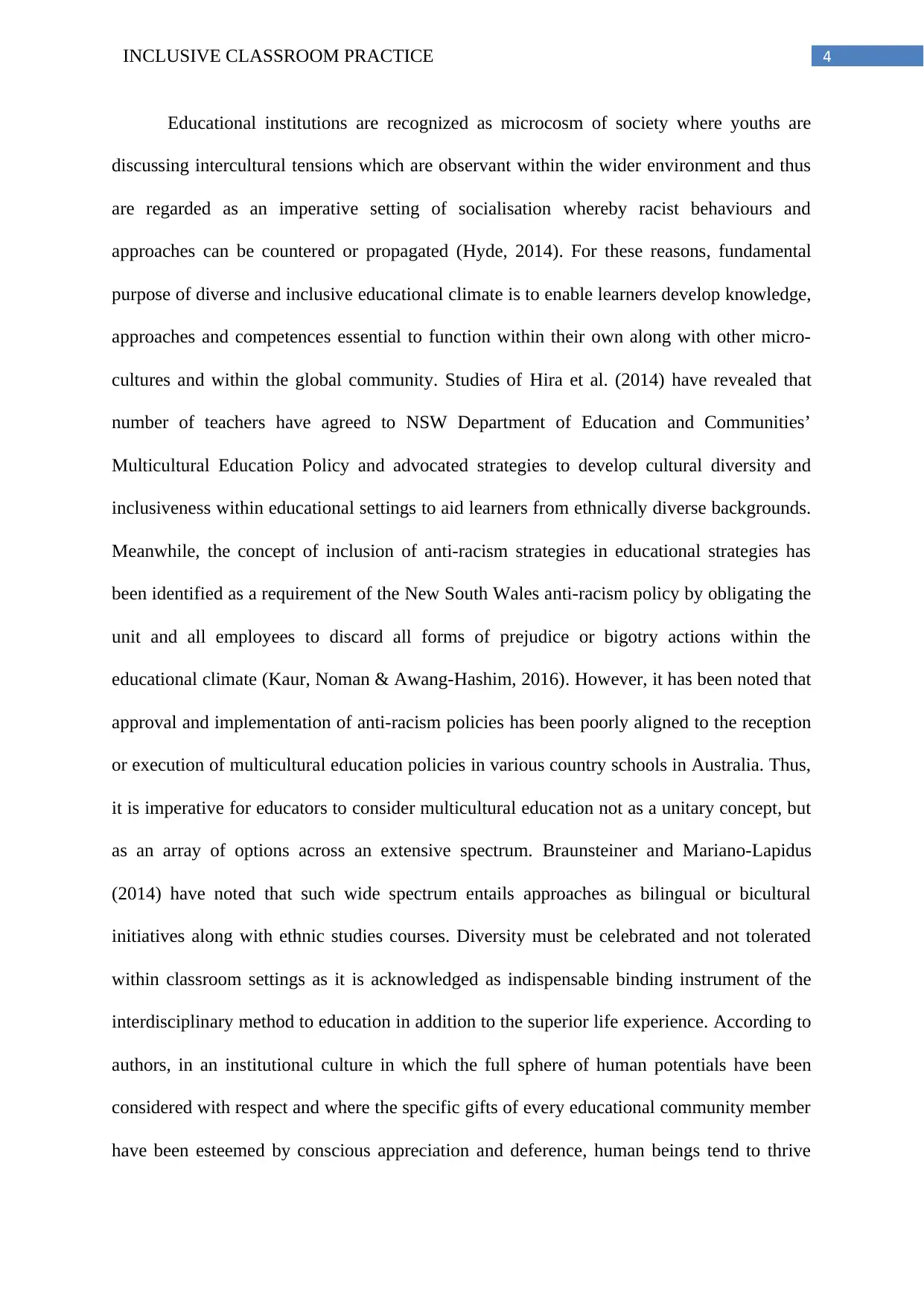
4INCLUSIVE CLASSROOM PRACTICE
Educational institutions are recognized as microcosm of society where youths are
discussing intercultural tensions which are observant within the wider environment and thus
are regarded as an imperative setting of socialisation whereby racist behaviours and
approaches can be countered or propagated (Hyde, 2014). For these reasons, fundamental
purpose of diverse and inclusive educational climate is to enable learners develop knowledge,
approaches and competences essential to function within their own along with other micro-
cultures and within the global community. Studies of Hira et al. (2014) have revealed that
number of teachers have agreed to NSW Department of Education and Communities’
Multicultural Education Policy and advocated strategies to develop cultural diversity and
inclusiveness within educational settings to aid learners from ethnically diverse backgrounds.
Meanwhile, the concept of inclusion of anti-racism strategies in educational strategies has
been identified as a requirement of the New South Wales anti-racism policy by obligating the
unit and all employees to discard all forms of prejudice or bigotry actions within the
educational climate (Kaur, Noman & Awang-Hashim, 2016). However, it has been noted that
approval and implementation of anti-racism policies has been poorly aligned to the reception
or execution of multicultural education policies in various country schools in Australia. Thus,
it is imperative for educators to consider multicultural education not as a unitary concept, but
as an array of options across an extensive spectrum. Braunsteiner and Mariano-Lapidus
(2014) have noted that such wide spectrum entails approaches as bilingual or bicultural
initiatives along with ethnic studies courses. Diversity must be celebrated and not tolerated
within classroom settings as it is acknowledged as indispensable binding instrument of the
interdisciplinary method to education in addition to the superior life experience. According to
authors, in an institutional culture in which the full sphere of human potentials have been
considered with respect and where the specific gifts of every educational community member
have been esteemed by conscious appreciation and deference, human beings tend to thrive
Educational institutions are recognized as microcosm of society where youths are
discussing intercultural tensions which are observant within the wider environment and thus
are regarded as an imperative setting of socialisation whereby racist behaviours and
approaches can be countered or propagated (Hyde, 2014). For these reasons, fundamental
purpose of diverse and inclusive educational climate is to enable learners develop knowledge,
approaches and competences essential to function within their own along with other micro-
cultures and within the global community. Studies of Hira et al. (2014) have revealed that
number of teachers have agreed to NSW Department of Education and Communities’
Multicultural Education Policy and advocated strategies to develop cultural diversity and
inclusiveness within educational settings to aid learners from ethnically diverse backgrounds.
Meanwhile, the concept of inclusion of anti-racism strategies in educational strategies has
been identified as a requirement of the New South Wales anti-racism policy by obligating the
unit and all employees to discard all forms of prejudice or bigotry actions within the
educational climate (Kaur, Noman & Awang-Hashim, 2016). However, it has been noted that
approval and implementation of anti-racism policies has been poorly aligned to the reception
or execution of multicultural education policies in various country schools in Australia. Thus,
it is imperative for educators to consider multicultural education not as a unitary concept, but
as an array of options across an extensive spectrum. Braunsteiner and Mariano-Lapidus
(2014) have noted that such wide spectrum entails approaches as bilingual or bicultural
initiatives along with ethnic studies courses. Diversity must be celebrated and not tolerated
within classroom settings as it is acknowledged as indispensable binding instrument of the
interdisciplinary method to education in addition to the superior life experience. According to
authors, in an institutional culture in which the full sphere of human potentials have been
considered with respect and where the specific gifts of every educational community member
have been esteemed by conscious appreciation and deference, human beings tend to thrive
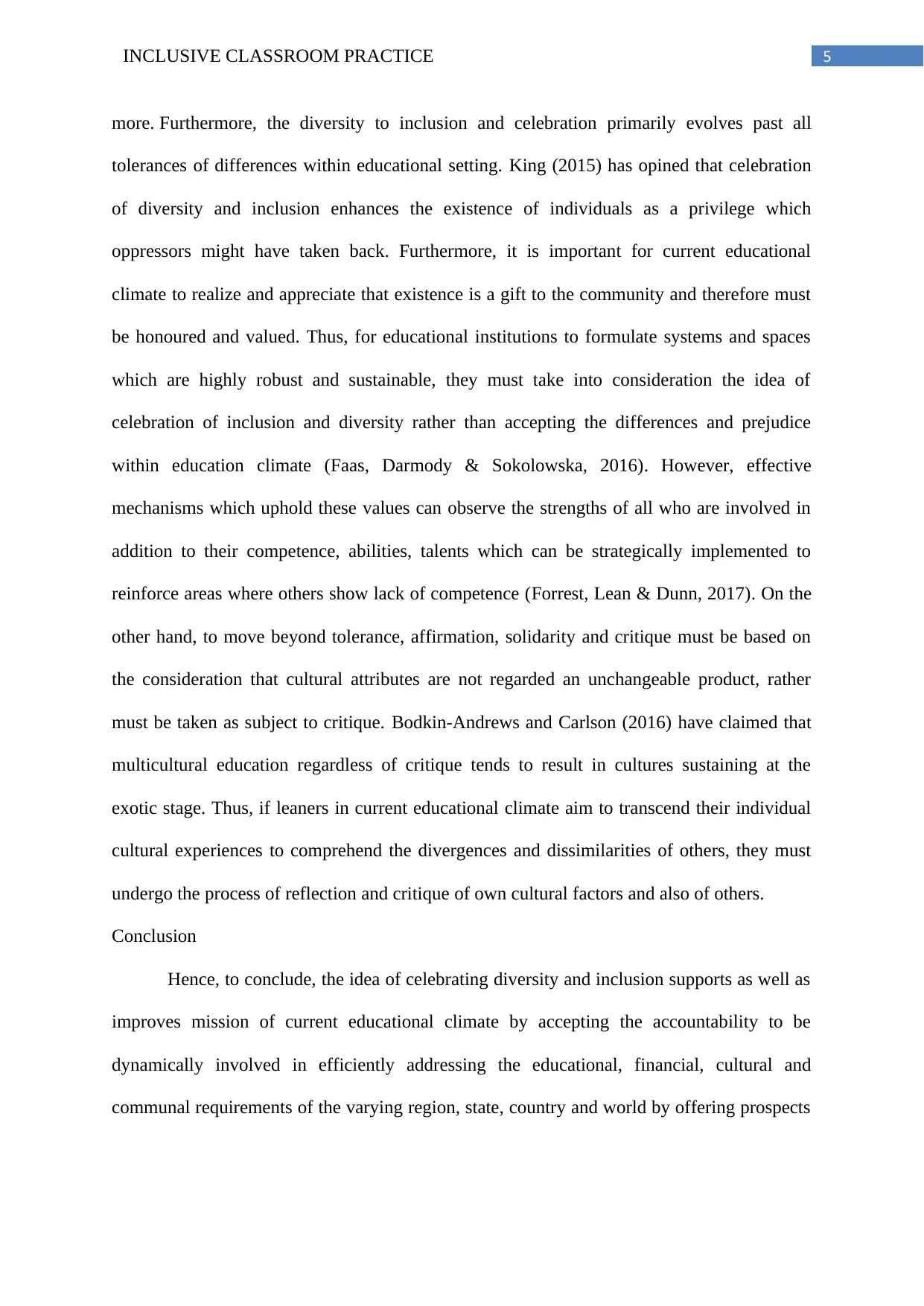
5INCLUSIVE CLASSROOM PRACTICE
more. Furthermore, the diversity to inclusion and celebration primarily evolves past all
tolerances of differences within educational setting. King (2015) has opined that celebration
of diversity and inclusion enhances the existence of individuals as a privilege which
oppressors might have taken back. Furthermore, it is important for current educational
climate to realize and appreciate that existence is a gift to the community and therefore must
be honoured and valued. Thus, for educational institutions to formulate systems and spaces
which are highly robust and sustainable, they must take into consideration the idea of
celebration of inclusion and diversity rather than accepting the differences and prejudice
within education climate (Faas, Darmody & Sokolowska, 2016). However, effective
mechanisms which uphold these values can observe the strengths of all who are involved in
addition to their competence, abilities, talents which can be strategically implemented to
reinforce areas where others show lack of competence (Forrest, Lean & Dunn, 2017). On the
other hand, to move beyond tolerance, affirmation, solidarity and critique must be based on
the consideration that cultural attributes are not regarded an unchangeable product, rather
must be taken as subject to critique. Bodkin-Andrews and Carlson (2016) have claimed that
multicultural education regardless of critique tends to result in cultures sustaining at the
exotic stage. Thus, if leaners in current educational climate aim to transcend their individual
cultural experiences to comprehend the divergences and dissimilarities of others, they must
undergo the process of reflection and critique of own cultural factors and also of others.
Conclusion
Hence, to conclude, the idea of celebrating diversity and inclusion supports as well as
improves mission of current educational climate by accepting the accountability to be
dynamically involved in efficiently addressing the educational, financial, cultural and
communal requirements of the varying region, state, country and world by offering prospects
more. Furthermore, the diversity to inclusion and celebration primarily evolves past all
tolerances of differences within educational setting. King (2015) has opined that celebration
of diversity and inclusion enhances the existence of individuals as a privilege which
oppressors might have taken back. Furthermore, it is important for current educational
climate to realize and appreciate that existence is a gift to the community and therefore must
be honoured and valued. Thus, for educational institutions to formulate systems and spaces
which are highly robust and sustainable, they must take into consideration the idea of
celebration of inclusion and diversity rather than accepting the differences and prejudice
within education climate (Faas, Darmody & Sokolowska, 2016). However, effective
mechanisms which uphold these values can observe the strengths of all who are involved in
addition to their competence, abilities, talents which can be strategically implemented to
reinforce areas where others show lack of competence (Forrest, Lean & Dunn, 2017). On the
other hand, to move beyond tolerance, affirmation, solidarity and critique must be based on
the consideration that cultural attributes are not regarded an unchangeable product, rather
must be taken as subject to critique. Bodkin-Andrews and Carlson (2016) have claimed that
multicultural education regardless of critique tends to result in cultures sustaining at the
exotic stage. Thus, if leaners in current educational climate aim to transcend their individual
cultural experiences to comprehend the divergences and dissimilarities of others, they must
undergo the process of reflection and critique of own cultural factors and also of others.
Conclusion
Hence, to conclude, the idea of celebrating diversity and inclusion supports as well as
improves mission of current educational climate by accepting the accountability to be
dynamically involved in efficiently addressing the educational, financial, cultural and
communal requirements of the varying region, state, country and world by offering prospects
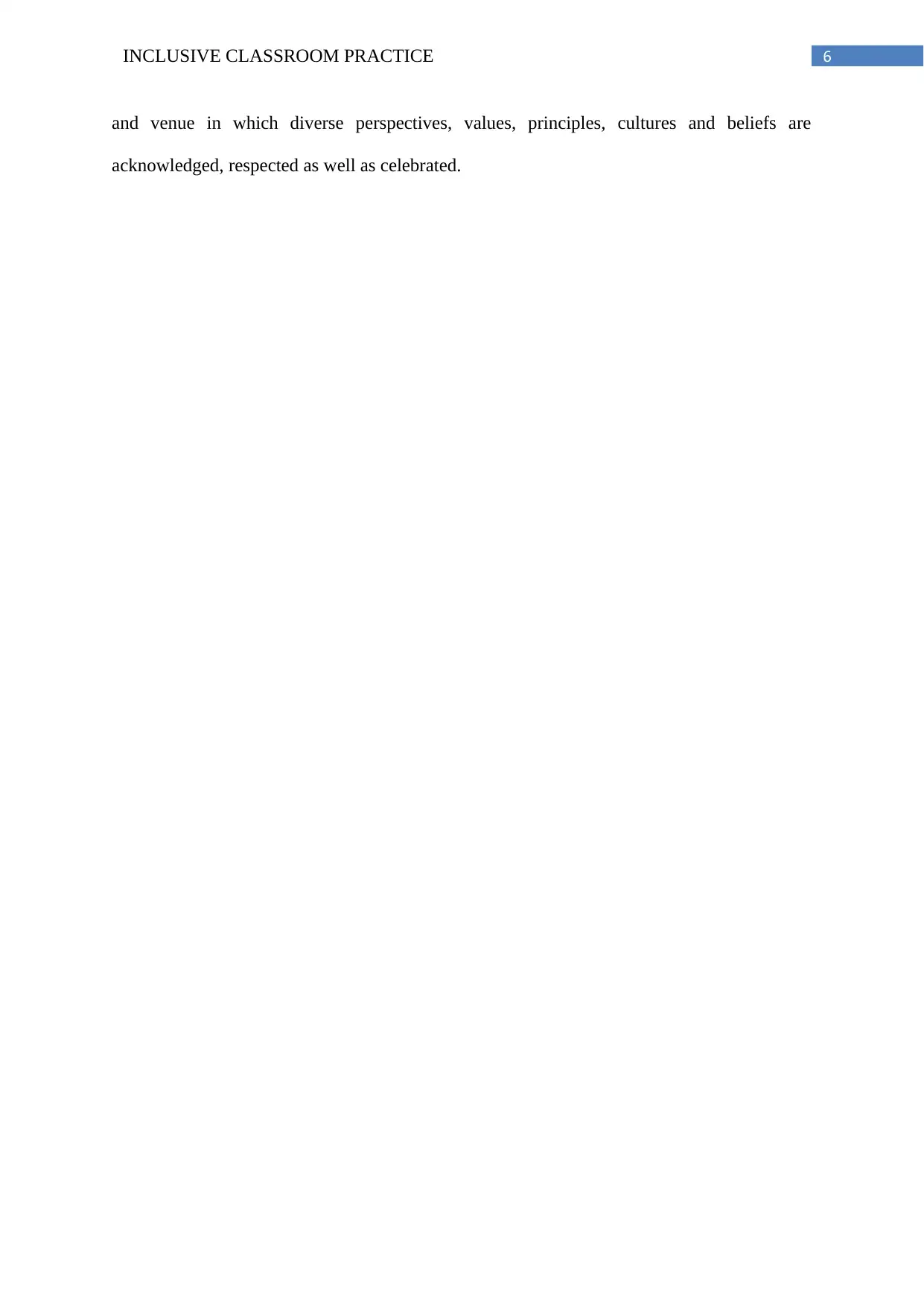
6INCLUSIVE CLASSROOM PRACTICE
and venue in which diverse perspectives, values, principles, cultures and beliefs are
acknowledged, respected as well as celebrated.
and venue in which diverse perspectives, values, principles, cultures and beliefs are
acknowledged, respected as well as celebrated.
Paraphrase This Document
Need a fresh take? Get an instant paraphrase of this document with our AI Paraphraser
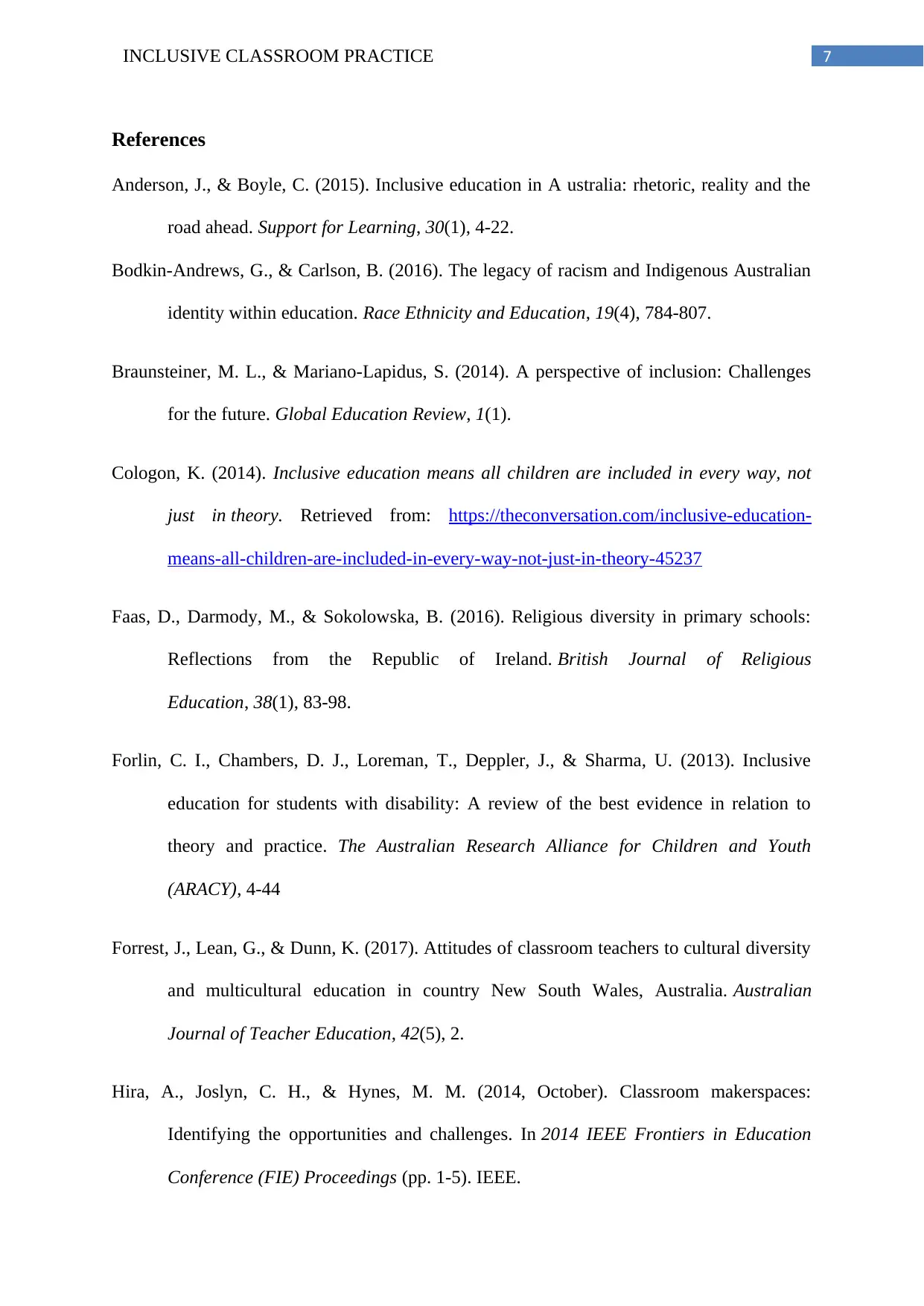
7INCLUSIVE CLASSROOM PRACTICE
References
Anderson, J., & Boyle, C. (2015). Inclusive education in A ustralia: rhetoric, reality and the
road ahead. Support for Learning, 30(1), 4-22.
Bodkin-Andrews, G., & Carlson, B. (2016). The legacy of racism and Indigenous Australian
identity within education. Race Ethnicity and Education, 19(4), 784-807.
Braunsteiner, M. L., & Mariano-Lapidus, S. (2014). A perspective of inclusion: Challenges
for the future. Global Education Review, 1(1).
Cologon, K. (2014). Inclusive education means all children are included in every way, not
just in theory. Retrieved from: https://theconversation.com/inclusive-education-
means-all-children-are-included-in-every-way-not-just-in-theory-45237
Faas, D., Darmody, M., & Sokolowska, B. (2016). Religious diversity in primary schools:
Reflections from the Republic of Ireland. British Journal of Religious
Education, 38(1), 83-98.
Forlin, C. I., Chambers, D. J., Loreman, T., Deppler, J., & Sharma, U. (2013). Inclusive
education for students with disability: A review of the best evidence in relation to
theory and practice. The Australian Research Alliance for Children and Youth
(ARACY), 4-44
Forrest, J., Lean, G., & Dunn, K. (2017). Attitudes of classroom teachers to cultural diversity
and multicultural education in country New South Wales, Australia. Australian
Journal of Teacher Education, 42(5), 2.
Hira, A., Joslyn, C. H., & Hynes, M. M. (2014, October). Classroom makerspaces:
Identifying the opportunities and challenges. In 2014 IEEE Frontiers in Education
Conference (FIE) Proceedings (pp. 1-5). IEEE.
References
Anderson, J., & Boyle, C. (2015). Inclusive education in A ustralia: rhetoric, reality and the
road ahead. Support for Learning, 30(1), 4-22.
Bodkin-Andrews, G., & Carlson, B. (2016). The legacy of racism and Indigenous Australian
identity within education. Race Ethnicity and Education, 19(4), 784-807.
Braunsteiner, M. L., & Mariano-Lapidus, S. (2014). A perspective of inclusion: Challenges
for the future. Global Education Review, 1(1).
Cologon, K. (2014). Inclusive education means all children are included in every way, not
just in theory. Retrieved from: https://theconversation.com/inclusive-education-
means-all-children-are-included-in-every-way-not-just-in-theory-45237
Faas, D., Darmody, M., & Sokolowska, B. (2016). Religious diversity in primary schools:
Reflections from the Republic of Ireland. British Journal of Religious
Education, 38(1), 83-98.
Forlin, C. I., Chambers, D. J., Loreman, T., Deppler, J., & Sharma, U. (2013). Inclusive
education for students with disability: A review of the best evidence in relation to
theory and practice. The Australian Research Alliance for Children and Youth
(ARACY), 4-44
Forrest, J., Lean, G., & Dunn, K. (2017). Attitudes of classroom teachers to cultural diversity
and multicultural education in country New South Wales, Australia. Australian
Journal of Teacher Education, 42(5), 2.
Hira, A., Joslyn, C. H., & Hynes, M. M. (2014, October). Classroom makerspaces:
Identifying the opportunities and challenges. In 2014 IEEE Frontiers in Education
Conference (FIE) Proceedings (pp. 1-5). IEEE.
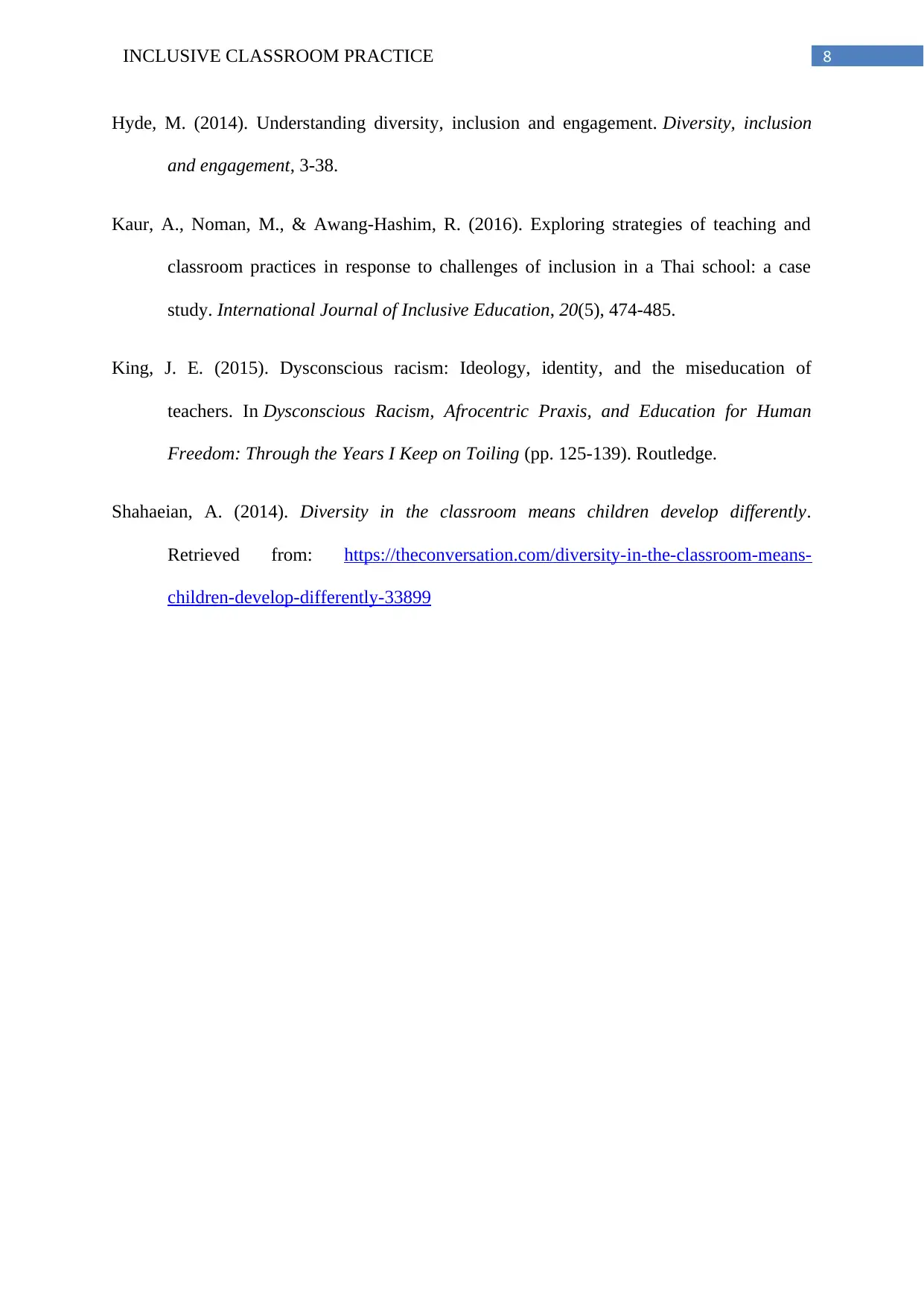
8INCLUSIVE CLASSROOM PRACTICE
Hyde, M. (2014). Understanding diversity, inclusion and engagement. Diversity, inclusion
and engagement, 3-38.
Kaur, A., Noman, M., & Awang-Hashim, R. (2016). Exploring strategies of teaching and
classroom practices in response to challenges of inclusion in a Thai school: a case
study. International Journal of Inclusive Education, 20(5), 474-485.
King, J. E. (2015). Dysconscious racism: Ideology, identity, and the miseducation of
teachers. In Dysconscious Racism, Afrocentric Praxis, and Education for Human
Freedom: Through the Years I Keep on Toiling (pp. 125-139). Routledge.
Shahaeian, A. (2014). Diversity in the classroom means children develop differently.
Retrieved from: https://theconversation.com/diversity-in-the-classroom-means-
children-develop-differently-33899
Hyde, M. (2014). Understanding diversity, inclusion and engagement. Diversity, inclusion
and engagement, 3-38.
Kaur, A., Noman, M., & Awang-Hashim, R. (2016). Exploring strategies of teaching and
classroom practices in response to challenges of inclusion in a Thai school: a case
study. International Journal of Inclusive Education, 20(5), 474-485.
King, J. E. (2015). Dysconscious racism: Ideology, identity, and the miseducation of
teachers. In Dysconscious Racism, Afrocentric Praxis, and Education for Human
Freedom: Through the Years I Keep on Toiling (pp. 125-139). Routledge.
Shahaeian, A. (2014). Diversity in the classroom means children develop differently.
Retrieved from: https://theconversation.com/diversity-in-the-classroom-means-
children-develop-differently-33899
1 out of 9
Related Documents
Your All-in-One AI-Powered Toolkit for Academic Success.
+13062052269
info@desklib.com
Available 24*7 on WhatsApp / Email
![[object Object]](/_next/static/media/star-bottom.7253800d.svg)
Unlock your academic potential
© 2024 | Zucol Services PVT LTD | All rights reserved.



